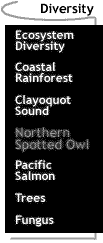Diversity: Northern Spotted Owl
Owl locations are found by setting up study areas of around 100 square miles. Three
hundred call stations, uniformly distributed, are established at each of the two study
areas. The stations are visited at night a minimum of six times a year. Once areas have
been established, the identity of the owls is ascertained as single owls or pairs. This
determination is made during the day by calling the owl and feeding it mice. If the owls
are nesting, the female will stay at the nest, while the male answers the call. The male
will then bring the mouse back to the nest. The owl can be followed back to the nest where
subsequent capture and banding takes place. Colored and numbered bands are used to track
the birds' movement. The nest is watched until the young leave. By tracking the owls and
monitoring the nesting success of each pair, it can be determined if they are sustaining
an intrinsic rate of population growth. In other words, a conclusion is reached as to
whether or not the owls can remain happy and healthy enough to sustain their population in
these habitats.
Once the demographic characteristics are documented, the owl pairs showing the best
reproduction ability will participate in a radio telemetry study. This stage, which will
be carried on for at least twelve months, enables specific habitat conditions such as the
kind of stand types [types of trees] the owls use for nesting, roosting and foraging to be
determined. Nicolet, J. (1995,
January-February). Providing for northern spotted owls in managed forest environment. Forest
Log, 64, p. 7. The Oregon Department of Forestry- Public Affairs



